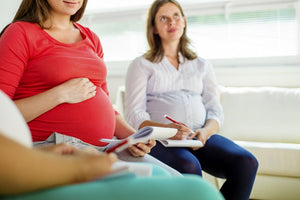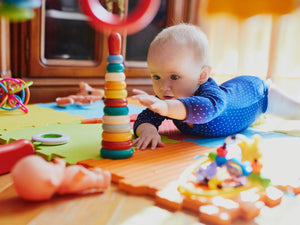Babies spend a huge amount of each day asleep in either their bassinet/cot or in their pram, so it’s important to consider the materials they are sleeping on when deciding how to choose the safest cot mattress for your baby.
Nowadays synthetic foams are commonly used in the production of all baby and also adult mattresses. Foam mattresses are produced using a concoction of Volatile Organic Compounds (VOC’s) including resins, various solvents and adhesives.
These synthetic materials off-gas constantly during their lifecycle and it is these VOC’s that young babies and children are exposed to in concentrated levels.
In recent years the health dangers of sleeping your baby on these mattresses have been studied and the results are anything but good, with strong links to SIDS, respiratory illness such as asthma and lung infections, autoimmune disorders and allergies.
As baby care seats and pram mattresses are also now produced with these toxic chemicals, young babies are literally receiving around the clock exposure to these VOC’s.
Environmental Engineer, Brandon Boor with his team at the University of Texas conducted a study on VOC’s levels emitted from the foam padding in crib mattresses and the results were alarming.
- New cot mattresses release 4 times higher levels of VOC’s than old mattresses do.
- A baby’s body heat significantly increases VOC’s emissions.
- The highest chemical emissions where measured in the area around babies immediate breathing zone (about 2.5 cm’s from the surface of the foam mattress).
Old cot mattresses are not safe either.
Scientific studies conducted by Dr Jim Sprott show that second-hand cot mattresses showed higher levels of fungus spores. This fungus combined with the VOC’s from the flame retardant chemicals increased the SIDS risk significantly.
The Safer Solution Is To Choose Certified Organic
Investing in a 100% certified organic cotton mattress and bedding for your child is the way to go. Before you buy, it is important to ensure the products have been officially certified ‘organic’ and are free of fire retardants and toxic dyes.
The brand my own family personally use and can highly recommend is Organature.
The difference between conventionally grown cotton and certified organic is important to understand. Certified Organic cotton crops are banned from using dangerous fungicides and pesticides and fungicides. Conventional cotton crops are heavily sprayed with toxic chemicals.
What to Avoid When Shopping for Baby’s Mattress
- Avoid the word ‘foam’, including Tempur Mattresses.
- Avoid the newer gel mattresses, as these are also highly synthetic.
- Made with ‘Natural Materials’ can be misleading advertising; e.g soy foam sounds natural but often contains petroleum.
- Latex mattresses – be aware that while some latex mattresses are made from natural rubber, others are created from synthetic rubber foams; e.g. Polyurethane foam.
- Do not buy any mattresses treated with fire retardant chemicals. Fire Retardant chemicals are linked to SIDS, cancer and a whole host of illnesses and allergies.
- Ask for full material and treatment disclosure from the mattress manufacturer.
- Never buy plastic coated cot mattresses. These coatings are used to protect the mattresses from stains and moisture but are usually made from toxic PVC plastic. PVC contains Phthalates, which off-gas carcinogenic dioxins. Polyester coatings should also be avoided as they contain unhealthy petrochemicals.
- If you choose to buy a conventional, synthetic cot and bassinet mattress (rather than choosing certified organic) then you should seriously consider The Mattress Wrapping Campaign protocol by Professor Jim Sprott. Over 200,000 mattresses have been wrapped according to his protocol and not one infant has died of SIDS.
- Assistant Professor Ying Xu recommends you air any non-organic mattresses for 6 months before use!
Finally never overheat your baby’s room and ensure the room has good airflow.
About the Author:
Nicole Groch is a loving mother, cruelty-free hair and makeup artist and founder of LivingSafe. After welcoming her first child 2007, she realised there was a serious lack of information about the safety of the materials and ingredients in baby products, toys, baby skincare and even baby foods. Since then, Nicole has spent years researching and writing about safe, healthy and eco-friendly alternatives for mums and bubs.
Our Products
-

01. Guide to a Healthy Pregnancy
$55 -

02. Positive Birthing Course
$55 -

03. Infant Feeding Guide
$55 -

04. Baby Sleep Guide - First 12 Months
$55 -

05. Toddler Parenting Course 1 - 3 Years
$55
-
 When to Start Antenatal Classes?
When to Start Antenatal Classes?
Becoming a parent is an incredible milestone, but it comes with a host of changes that can be daunting, especially for first time parents. Antenatal classes are all about offering expectant parents the education they need to make informed decisions, look after their bodies and care for their newborn babies. While you probably already have a long list of things you need to accomplish during your pregnancy, it’s a good idea to make time to attend antenatal classes.
-
 Development Milestones 4-8 Months
Development Milestones 4-8 Months
As they reach the middle of their first year, you'll start to see bigger leaps in their growth and ability!
In this article, we’re going to discuss your baby’s developmental milestones between 4-8 months, and what you can expect along the way.





 When to Start Antenatal Classes?
When to Start Antenatal Classes?
 Development Milestones 4-8 Months
Development Milestones 4-8 Months








